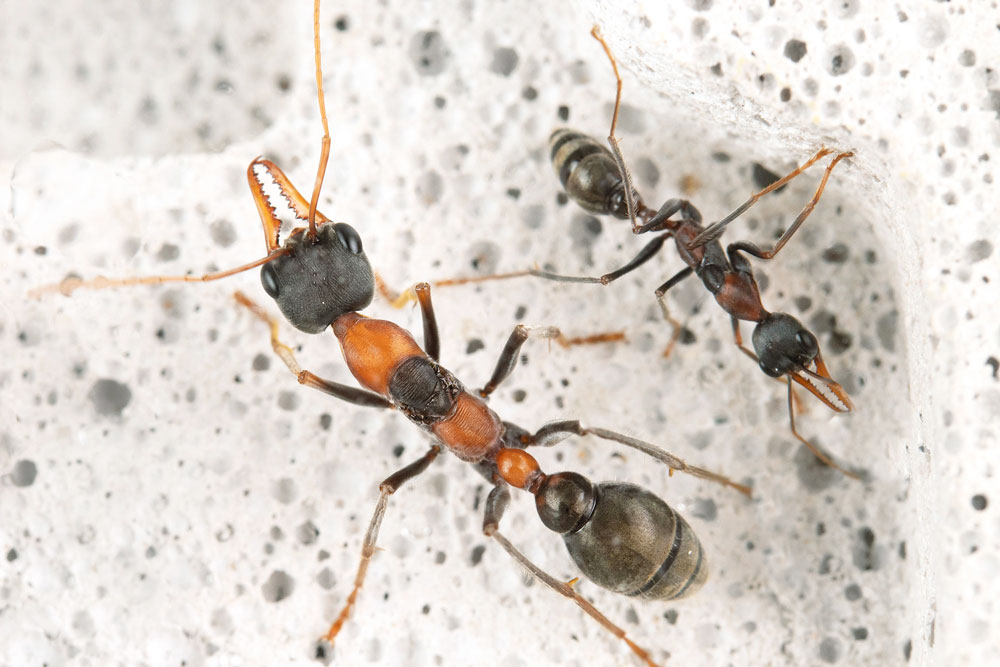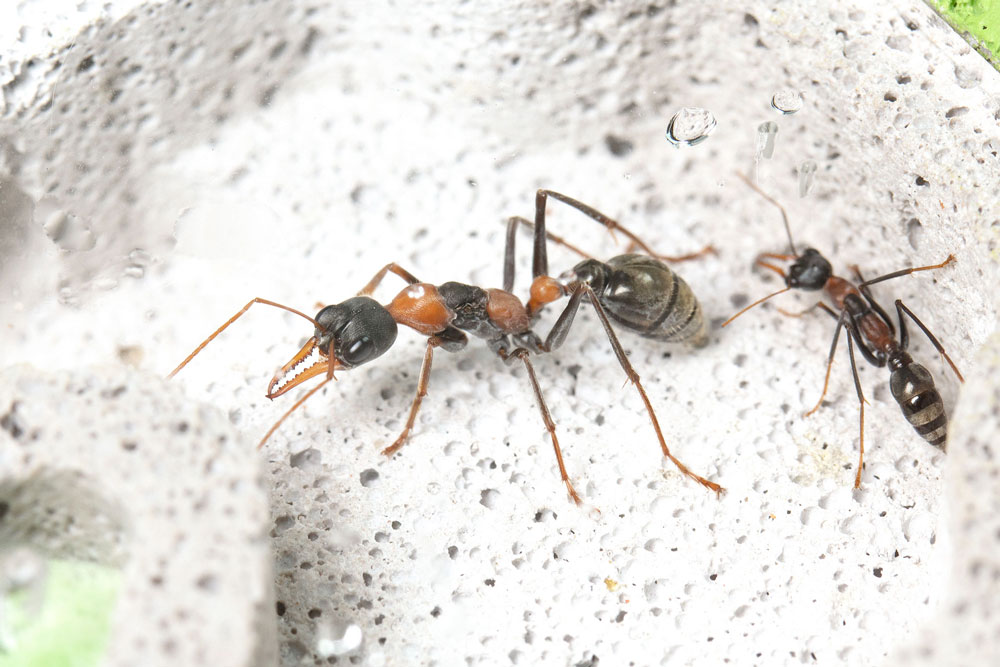AUS ANTS YTONG NESTS
We have been successfully keeping ants for many years. Now, we are proud to offer the very pinnacle in ant keeping technology. Our Ytong nests are of the highest quality and will easily satisfy the needs of amateur, and professional ant keepers alike.
** YTONG 2021 UPDATED DESIGNS AVAILABLE NOVEMBER 2021**
YTONG 2021 RANGE
Founding
Available individually and starter kit
Suitable for 1 to 500 ants
Length - 84 mm
Width - 65 mm
Overall Depth - 45 mm
Chamber Depth - 10+5 mm
Small
Available individually
Suitable for 50 to 1,000 ants
Length - 120 mm
Width - 95 mm
Overall Depth - 45 mm
Chamber Depth - 10+5 mm
Medium
Available individually
Suitable for 100 to 2,000 ants
Length - 175 mm
Width - 135 mm
Overall Depth - 45 mm
Chamber Depth - 10+5 mm
Large
Available individually
Suitable for 200 to 5,000 ants
Length - 245 mm
Width - 195 mm
Overall Depth - 45 mm
Chamber Depth - 10+5 mm
WHY PICK oUR YTONG NESTS?
Here at Aus Ants, we have been keeping ants for many years. To develop our Ytong nests we poured all of our knowledge and ant keeping experience into designing, producing, and then meticulously testing hundreds of nests, until eventually, we arrived at our current designs. Each aspect has been carefully considered and developed with both the occupants and caretakers in mind. We strongly believe that our Ytong nests are the best formicaria on the market!
How can we make such bold claims? Well, after extensive testing we became a real fan of Ytong and its beneficial properties, but this material alone was not enough to guarantee the success of our colonies. We quickly realised that the design of the nests and how it is manufactured is of the utmost importance. Therefore, we work very hard to ensure the end result is nothing short of perfection.
Some of our favourite features of our Ytong nests include...The Ytong itself! From the moisture retentive properties that lead to stable humidity levels...to its excellent insulative properties, helping to keep temperature fluctuations to a minimum (much like wild ants living underground would be accustomed to)...to the material's porous surface, making it easy for any type of ant to grip onto, as well as aiding the developing larvae in the spinning of their protective silken cocoons. Ytong really is perfect for the job!
The removable, crystal-clear acrylic lids are secured in place by stainless steel bolts which are screwed into a machined metal thread embedded into the Ytong. This not only provides a clearer view of the ants but also allows easy removal of the lid for cleaning purposes. The lids also feature laser cut micro holes for improved ventilation.
The entrance/exit holes are designed to holster standard 10mm internal (13mm external) vinyl tubing, which is the same height as the main chambers of the nest. This allows the ants to travel in and out of the nest unhindered by a reduction of tube diameter surrounding the connection point (which often results in bottle-necking of the ants' traffic). This also allows larger species to comfortably enter/exit the nest.
SO WHAT IS YTONG?
The primary ingredient; Ytong is a versatile, high performance and durable material. It is often branded as 'Hebel' in Australia and is made from autoclaved aerated concrete (AAC for short). AAC replicates minerals found in nature. It is made of raw materials such as sand, cement, lime and gypsum, which is then combined with water and an expansion agent. The mixture then expands with the help of a gas, giving the material its highly porous qualities. This creates a sturdy, yet extremely light material. Perfect for the nurturing of an ant colony.
AAC is...
Non toxic
Highly sustainable
Produced locally in Australia
Naturally mold resistant
A fantastic thermal insulator
Moisture retentive with high dispersion qualities
ANT SHIELDS
Made of high clarity, crystal clear acrylic, these shields are specifically designed to be placed upon a corresponding sized nest within our range of Ytong and Acrylic designs.
What are they for? Well, many species of ants, (and other insects too) are unable to sense wavelengths within the red light spectrum. So, when the shields are fitted, the ants are fooled into thinking they’re safe within the security of darkness (as ant colonies would naturally be in the wild). Like a one way mirror, the keeper can see in, but the ants can’t see out. Thus, allowing for a more natural, disturbance free view of all the exciting happenings within the nest. Just keep in mind, the effectiveness of the shields may vary from species to species, and works best under low light intensities.
Plus, as the shields completely cover the lids of their corresponding nests, they also help protect the lids beneath from dust accumulation and scratching. The shields are designed to comfortably rest on top of the nests’ screws, leaving a very thin, but important, gap between them and the clear acrylic lid below. Thus, preventing the two rubbing together and forming unsightly marks and scratches.
Additional holes have been carefully cut into the shields. Some for hydration, allowing the keeper to inject water directly into the nests’ hydration chambers without having to remove the shields, and other, smaller holes are present for ventilation purposes.
Our ‘Ant Shields’ come included in our ‘Acrylic/Ytong Starter Kits’ and are sold separately for our ‘Small’, ‘Medium’ and ‘Large’ sized nests.
YTONG oR ACRYLIC NEST? HOW TO DECIDE?
Both our acrylic and ytong nests are perfectly suitable for raising virtually all ant species, so it mostly boils down to personal preference. We feel however, that ytong is the superior, but not in all cases...
YTONG
The main advantages of ytong (used in our nests) is that it is extremely water retentive, so you won't have to hydrate the nest as often as the acrylic designs. They also offer a slightly larger chamber depth (10mm) when compared with our acrylic nests (9mm). Making them more suitable for larger ants, such as Bull Ants (Myrmecia spp.). The material also possesses greater insulative properties. Which is ideal for keeping temperature and humidity levels stable (replicating the conditions wild ants would experience when living below the ground surface).
Another advantage of the material is the surface texture. The rough, porous surface allows the ants to easily grip on, offering them maximum maneuverability (especially useful for ant species which have trouble gripping onto smooth surfaces, such as plastic and glass). Plus, this improved grip can also aid the ant larvae in the spinning of their cocoons.
With a little DIY work, (using a screwdriver or a drill) the inner chambers can easily be carved. Giving you the option of increasing chamber depth to accommodate for larger ant species or colonies, or to better match your unique aesthetic needs! We demonstrate how best to carve ytong in Part 2 of our ‘How to Build an Ant Nest’ video series here.
ACRYLIC
One advantage of acrylic is that it is assembled extremely securely. Making it a great choice for tiny ant species which may be able to squeeze through the lids of our porous Ytong designs (such as Monomorium spp.). Plus, the robust nature of acrylic allows it to be infinitely reused. Simply move your colony out, disassemble the nest, give it a good clean under some hot water, then reassemble, and it’s ready to house ants once again!
HOW TO USE?
HYDRATION
Our ytong nests requires around 5-10 ml of water every 4 to 6 days, depending upon ambient temperature and the particular ant species being housed (as some ants may prefer their nest wetter or drier than others). We advise doing some research and experimenting in order to determine your ant species’ ideal humidity preferences.
To reduce the risk of ‘over-hydration’ of the nest, moisten the sponge slowly so that the water can be properly absorbed. Ytong is a highly porous material so shortly after hydration, the sponge may appear to be dry, however, this not a sign that the nest is in need of more moisture, the water has simply transferred into the Ytong itself. It is the Ytong which regulates the humidity of the nest by slowly releasing this moisture evenly over time, not the sponges.
LEARN MORE
To learn more about our range of Ytong formicaria and how best to use them, we highly recommend watching this informative introductory video below that we developed with Jordan Dean.














